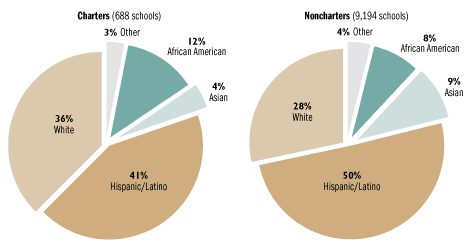The first charter school in the US was established in 1992 in St. Paul, Minnesota. Numbers of charter schools grew steadily with the introduction of supporting legislation that was often written with the help of Education Management Oganizations (EMOs).
More recently charter schools have been facilitated by the No Child Left Behind (NCLB) legislation, which can require failing schools to convert to charter schools or for their  management to be taken over by EMOs.
management to be taken over by EMOs.
By 2013 there were more than 6000 charter schools in 42 states and the District of Columbia covering 2.3 million students.
Rather than having to comply with the government regulations that are applied to normal public schools, charter schools are bound by a charter, which is a contract that includes the ‘school’s mission, academic goals and accountability procedures’. The freedom from regulation and bureaucracy is supposed to enable the charter schools to innovate; to introduce different curricula and teaching methods – including online classes – so as to offer choice in the type of school available to parents.

Student Populations in California Charter and Noncharter Schools, 2009
Because charter schools tend to be located in low income neighbourhoods, or are set up to cater to a particular religious or ethnic group, they tend to increase segregation of children by class and ethnicity, which goes against a traditional aim of public education – to provide shared knowledge and values to children from diverse backgrounds.
In wealthy neighbourhoods, public schools are well resourced, with higher salaried teachers and consequently they are offer a high quality education. There is little reason to establish charter schools in such neighbourhoods. The argument that the private sector can do it better has little credibility when schools are well resourced. For this reason, charter schools tend to operate in inner city areas in the US, where they are attended by a higher proportion of low-income, black and Hispanic students than the average public school.
 Charter schools, like KIPP and Edison schools, put in place the same rigidly structured back-to-basics curriculum across all their schools; a longer school day and longer school year; an emphasis on discipline and structured lessons; centralised control over what happens in the schools; performance pay for teachers and principals; and constant testing of students.
Charter schools, like KIPP and Edison schools, put in place the same rigidly structured back-to-basics curriculum across all their schools; a longer school day and longer school year; an emphasis on discipline and structured lessons; centralised control over what happens in the schools; performance pay for teachers and principals; and constant testing of students.
Charter school managers often assume that a major cause of problems in urban schools is lack of discipline rather than lack of funding and resources, neighbourhood and family poverty, or the feelings of hopelessness caused by high levels of unemployment in the area. Discipline is thought to be necessary to make students learn against their natural tendency to play up.
 The private provision of online schooling has also been problematic. In early 2006 there were 147 online charter schools in 18 states catering to over 65,000 children. These schools provide students with computer equipment, software, textbooks but don’t have to provide buildings, transportation, food catering, or extracurricular activities so they can make big profits on public funding.
The private provision of online schooling has also been problematic. In early 2006 there were 147 online charter schools in 18 states catering to over 65,000 children. These schools provide students with computer equipment, software, textbooks but don’t have to provide buildings, transportation, food catering, or extracurricular activities so they can make big profits on public funding.
 State auditors in Colorado called for a moratorium on online schools after finding that they were not properly regulated, that their students performed worse than other students on state exams and their performance got worse over time; and that students were more likely to drop out. Five out of the 18 online schools did not employ teachers who had completed college courses in the subjects they were teaching, as required by federal regulations. Such schools generally rely on parents to provide much of the teaching. One school, for example, had only four licensed teachers for 1500 students.
State auditors in Colorado called for a moratorium on online schools after finding that they were not properly regulated, that their students performed worse than other students on state exams and their performance got worse over time; and that students were more likely to drop out. Five out of the 18 online schools did not employ teachers who had completed college courses in the subjects they were teaching, as required by federal regulations. Such schools generally rely on parents to provide much of the teaching. One school, for example, had only four licensed teachers for 1500 students.
There has also been some controversy recently about the outsourcing of student essay marking by virtual schools to tutors in India and elsewhere.
By 2011 there were 200,000 children across the US using virtual schooling, many of them enrolled in sc hools run by for-profit companies. Studies are still finding that these students are not performing as well as equivalent students in regular schools - see graph.
hools run by for-profit companies. Studies are still finding that these students are not performing as well as equivalent students in regular schools - see graph.
The New York Times examined one of these K12 Inc (originally founded with the help of William Bennett) and found "a company that tries to squeeze profits from public school dollars by raising enrollment, increasing teacher workload and lowering standards".
Teachers have had to take on more and more students, relaxing rigor and achievement along the way, according to interviews. While teachers do not have the burden of a full day of classes, they field questions from families, monitor students’ progress and review and grade schoolwork. Complaints about low pay and high class loads — with some high school teachers managing more than 250 students... Some teachers at K12 schools said they felt pressured to pass students who did little work. Teachers have also questioned why some students who did no class work were allowed to remain on school rosters, potentially allowing the company to continue receiving public money for them.
If you have any examples or updates you would like to contribute please email them to me and I will add them here. Please give references for where you sourced the information.